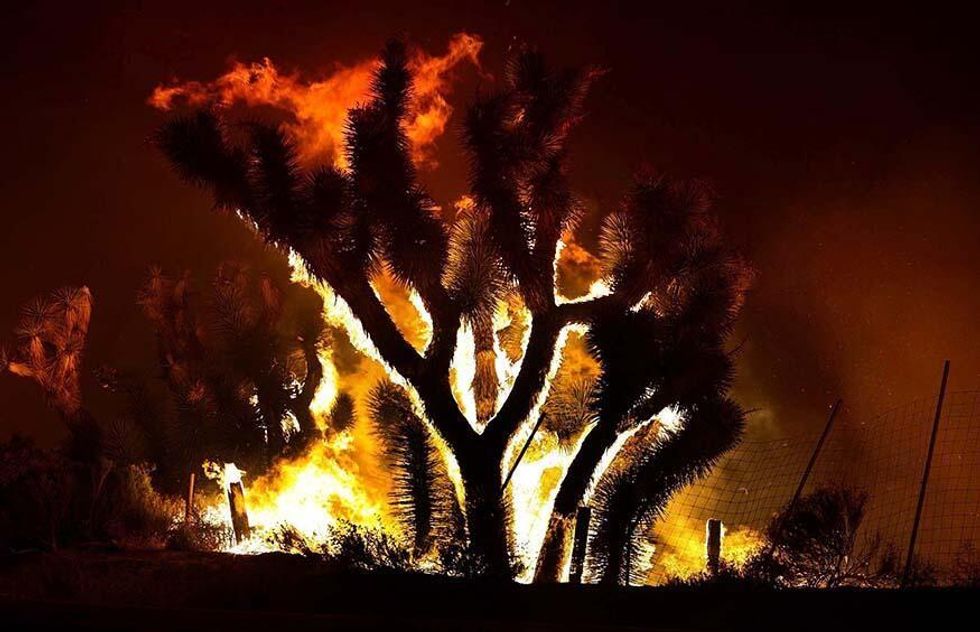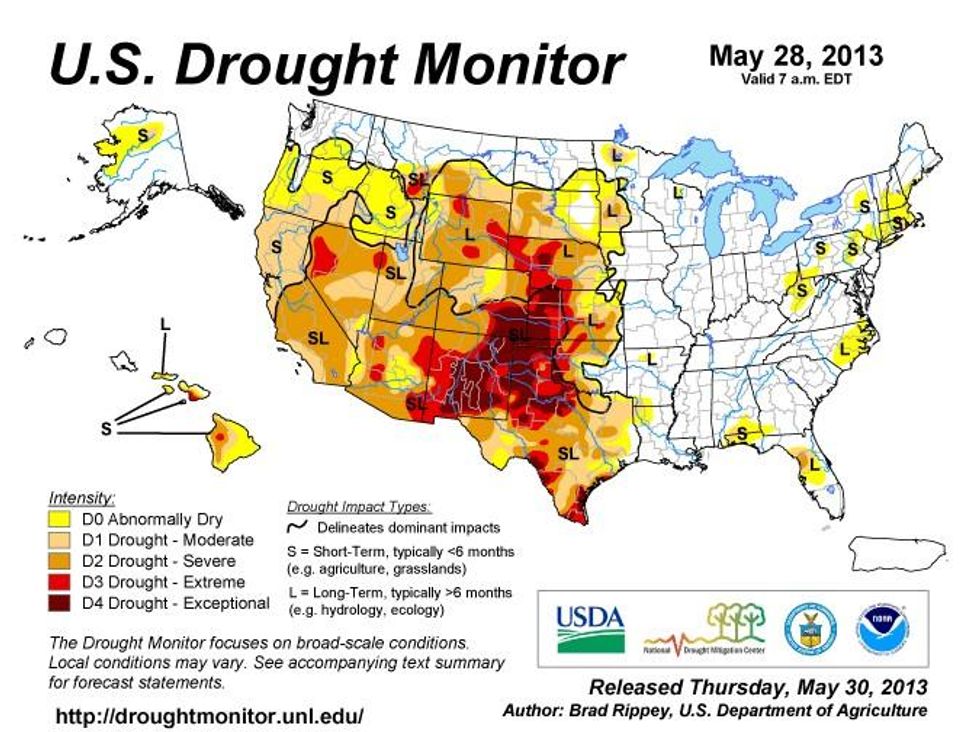

SUBSCRIBE TO OUR FREE NEWSLETTER
Daily news & progressive opinion—funded by the people, not the corporations—delivered straight to your inbox.
5
#000000
#FFFFFF
To donate by check, phone, or other method, see our More Ways to Give page.


Daily news & progressive opinion—funded by the people, not the corporations—delivered straight to your inbox.

In testimony to the Senate Energy and Natural Resources Committee, U.S. Forest Service Chief Thomas Tidwell said:
Around the world, the last two decades have seen fires that are extraordinary in their size, intensity and impacts. In Australia in 2009, the Black Saturday Bushfires killed 170 people. Domestically, Florida, Georgia, Utah, California, Texas, Arizona, New Mexico and Colorado, have all experienced the largest and/or the most destructive fires in their history just in the last six years. On average wildfires burn twice as many acres each year as compared to 40 years ago, and there are on average seven times as many fires over 10,000 acres per year.
In 2012 over 9.3 million acres burned in the United States. The fires of 2012 were massive in size, with 51 fires exceeding 40,000 acres. Of these large fires, 14 exceeded 100,000 acres. The increase in large fires in the west coincides with an increase in temperatures and early snow melt in recent years. This means longer fire seasons. The length of the fire season has increased by over two months since the 1970s.
"The largest issue we now face is how to adapt our management to anticipate climate change impacts and to mitigate their potential effects," Tidwell told the committee.
Illustrating how climate change has quickly impacted on wildfires, Tidwell told the Guardian, "Ten years ago in New Mexico outside Los Alamos we had a fire get started. Over seven days, it burned 40,000 acres. In 2011, we had another fire. Las Conchas. It also burned 40,000 acres. It did it in 12 hours."
Last week, Santa Barbara County fire Capt. David Sadecki said of the White Fire that burned nearly 2,000 acres in southern California, "It's still spring--it's not even summer--and it's burning like it's August or September."
These increasingly severe wildfires have a monetary effect as well. Fire activities represented 13 percent of the U.S. Forest Service's total agency budget in 1991, but that figure jumped to over 40 percent in 2012.
In the most recent wildfire potential outlook released June 1 by the National Interagency Fire Center, warmer, drier than usual conditions are contributing to above normal potential for wildfires in large swathes of the west. And the most recent drought monitor shows dry conditions plaguing much of the western half of the country.

________________________
Dear Common Dreams reader, The U.S. is on a fast track to authoritarianism like nothing I've ever seen. Meanwhile, corporate news outlets are utterly capitulating to Trump, twisting their coverage to avoid drawing his ire while lining up to stuff cash in his pockets. That's why I believe that Common Dreams is doing the best and most consequential reporting that we've ever done. Our small but mighty team is a progressive reporting powerhouse, covering the news every day that the corporate media never will. Our mission has always been simple: To inform. To inspire. And to ignite change for the common good. Now here's the key piece that I want all our readers to understand: None of this would be possible without your financial support. That's not just some fundraising cliche. It's the absolute and literal truth. We don't accept corporate advertising and never will. We don't have a paywall because we don't think people should be blocked from critical news based on their ability to pay. Everything we do is funded by the donations of readers like you. Will you donate now to help power the nonprofit, independent reporting of Common Dreams? Thank you for being a vital member of our community. Together, we can keep independent journalism alive when it’s needed most. - Craig Brown, Co-founder |

In testimony to the Senate Energy and Natural Resources Committee, U.S. Forest Service Chief Thomas Tidwell said:
Around the world, the last two decades have seen fires that are extraordinary in their size, intensity and impacts. In Australia in 2009, the Black Saturday Bushfires killed 170 people. Domestically, Florida, Georgia, Utah, California, Texas, Arizona, New Mexico and Colorado, have all experienced the largest and/or the most destructive fires in their history just in the last six years. On average wildfires burn twice as many acres each year as compared to 40 years ago, and there are on average seven times as many fires over 10,000 acres per year.
In 2012 over 9.3 million acres burned in the United States. The fires of 2012 were massive in size, with 51 fires exceeding 40,000 acres. Of these large fires, 14 exceeded 100,000 acres. The increase in large fires in the west coincides with an increase in temperatures and early snow melt in recent years. This means longer fire seasons. The length of the fire season has increased by over two months since the 1970s.
"The largest issue we now face is how to adapt our management to anticipate climate change impacts and to mitigate their potential effects," Tidwell told the committee.
Illustrating how climate change has quickly impacted on wildfires, Tidwell told the Guardian, "Ten years ago in New Mexico outside Los Alamos we had a fire get started. Over seven days, it burned 40,000 acres. In 2011, we had another fire. Las Conchas. It also burned 40,000 acres. It did it in 12 hours."
Last week, Santa Barbara County fire Capt. David Sadecki said of the White Fire that burned nearly 2,000 acres in southern California, "It's still spring--it's not even summer--and it's burning like it's August or September."
These increasingly severe wildfires have a monetary effect as well. Fire activities represented 13 percent of the U.S. Forest Service's total agency budget in 1991, but that figure jumped to over 40 percent in 2012.
In the most recent wildfire potential outlook released June 1 by the National Interagency Fire Center, warmer, drier than usual conditions are contributing to above normal potential for wildfires in large swathes of the west. And the most recent drought monitor shows dry conditions plaguing much of the western half of the country.

________________________

In testimony to the Senate Energy and Natural Resources Committee, U.S. Forest Service Chief Thomas Tidwell said:
Around the world, the last two decades have seen fires that are extraordinary in their size, intensity and impacts. In Australia in 2009, the Black Saturday Bushfires killed 170 people. Domestically, Florida, Georgia, Utah, California, Texas, Arizona, New Mexico and Colorado, have all experienced the largest and/or the most destructive fires in their history just in the last six years. On average wildfires burn twice as many acres each year as compared to 40 years ago, and there are on average seven times as many fires over 10,000 acres per year.
In 2012 over 9.3 million acres burned in the United States. The fires of 2012 were massive in size, with 51 fires exceeding 40,000 acres. Of these large fires, 14 exceeded 100,000 acres. The increase in large fires in the west coincides with an increase in temperatures and early snow melt in recent years. This means longer fire seasons. The length of the fire season has increased by over two months since the 1970s.
"The largest issue we now face is how to adapt our management to anticipate climate change impacts and to mitigate their potential effects," Tidwell told the committee.
Illustrating how climate change has quickly impacted on wildfires, Tidwell told the Guardian, "Ten years ago in New Mexico outside Los Alamos we had a fire get started. Over seven days, it burned 40,000 acres. In 2011, we had another fire. Las Conchas. It also burned 40,000 acres. It did it in 12 hours."
Last week, Santa Barbara County fire Capt. David Sadecki said of the White Fire that burned nearly 2,000 acres in southern California, "It's still spring--it's not even summer--and it's burning like it's August or September."
These increasingly severe wildfires have a monetary effect as well. Fire activities represented 13 percent of the U.S. Forest Service's total agency budget in 1991, but that figure jumped to over 40 percent in 2012.
In the most recent wildfire potential outlook released June 1 by the National Interagency Fire Center, warmer, drier than usual conditions are contributing to above normal potential for wildfires in large swathes of the west. And the most recent drought monitor shows dry conditions plaguing much of the western half of the country.

________________________